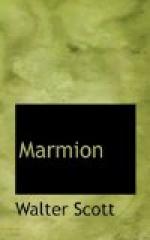After the descriptions and the characterisation, the remaining important features of the poem are its marked practical irony and its episodes. Marmion, despite his many excellences, is throughout--and for obvious reasons—the victim of a persistent Nemesis. Scott is much interested in his hero; one fancies that if it were only possible he would in the end extend his favour to him, and grant him absolution; but his sense of artistic fitness prevails, and he will abate no jot of the painful ordeal to which he feels bound to submit him. Marmion is a knight with a claim to nothing more than the half of the proverbial qualifications. He is sans peur, but not sans reproche; and it is one expression of the practical irony that constantly lurks to assail him that even his fearlessness quails for a time before the Phantom Knight on Gifford Moor. The whole attitude of the Palmer is ironical; and, after the bitter parting with Angus at Tantallon, Marmion is weighted with the depressing reflection that numerous forces are conspiring against him, and with the knowledge that it is his old rival De Wilton that has thrown off the Palmer’s disguise and preceded him to the scene of war. In his last hour the practical irony of his position bears upon him with a concentration of keen and bitter thrusts. Clare, whom he intended to defraud, ministers to his last needs; he learns that Constance died a bitter death at Lindisfarne; and just when he recognises his greatest need of strength his life speedily ebbs away. There is a certain grandeur of impressive tragical effort in his last struggles, as he feels that whatever he may himself have been he suffers in the end from the merciless machinery of a false ecclesiastical system. The practical irony follows him even after his death, for it is a skilful stroke that leaves his neglected remains on the field of battle and places a nameless stranger in his stately tomb.
As regards the episodes, it may just be said in a word that they are appropriate, and instead of retarding the movement of the piece, as has sometimes been alleged, they serve to give it breadth and massiveness of effect. Of course, there will always be found those who think them too long, just as there are those whose narrowness of view constrains them to wish the Introductions away. If the poet’s conception of Marmion be fully considered, it will be seen that the Host’s Tale is an integral part of his purpose; and there is surely no need to defend either Sir David Lyndsay’s Tale or the weird display at the cross of Edinburgh. The episode of Lady Heron’s singing carries its own defence in itself, seeing that the song of ‘Lochinvar’ holds a place of distinction among lyrics expressive of poetical motion. After all, we must bear in mind that though it pleases Scott to speak of his tale as flowing on ’wild as cloud, as stream, as gale,’ he was still conscious that he was engaged upon a poem, and that a poem is regulated by certain artistic laws. If we strive to grasp his meaning we shall not be specially inclined to carp at his method. It may at the same time be not unprofitable to look for a moment at some of the notable criticisms of the poem.




